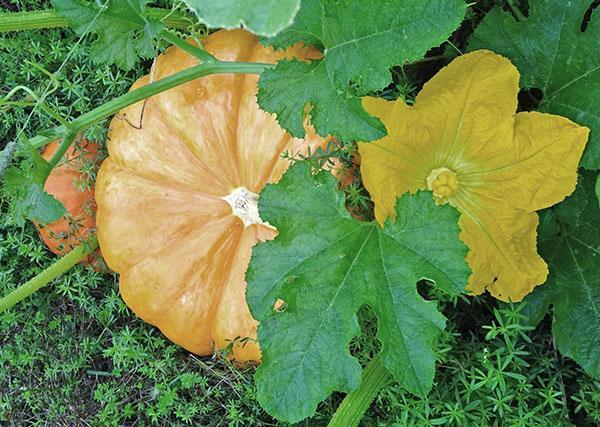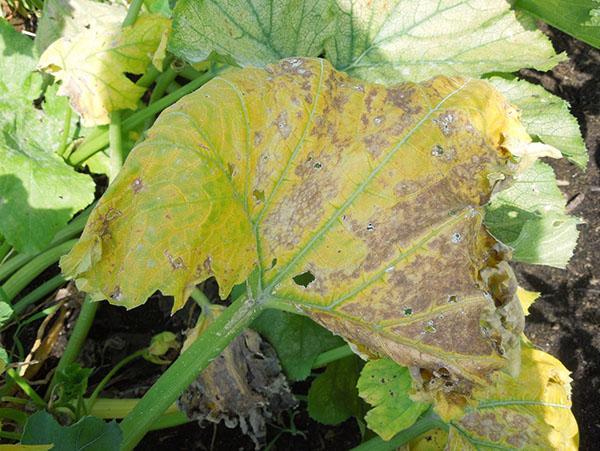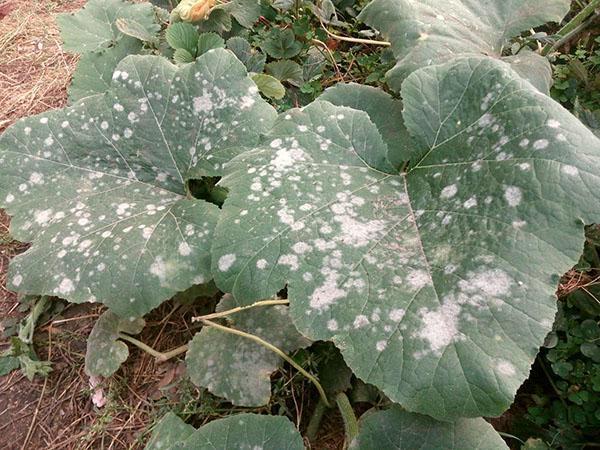Dangerous pumpkin diseases: description and control methods
 Most summer residents grow the "mistress" of all vegetables in the garden. It is particularly resistant to external factors, but some pumpkin diseases can cause irreparable harm to it. To cope with them, it is extremely important for the gardener to notice them at an early stage of development and act immediately. Otherwise, the family will be left without a valuable product, which includes an abundance of nutrients. Consider the main signs of plant damage and how to deal with them.
Most summer residents grow the "mistress" of all vegetables in the garden. It is particularly resistant to external factors, but some pumpkin diseases can cause irreparable harm to it. To cope with them, it is extremely important for the gardener to notice them at an early stage of development and act immediately. Otherwise, the family will be left without a valuable product, which includes an abundance of nutrients. Consider the main signs of plant damage and how to deal with them.
Common pumpkin diseases: external characteristics and causes

Like any garden plant, the culture needs proper care, including weeding and loosening the soil. Otherwise, weeds can become carriers of harmful infections, fungi and pests.
Powdery mildew - fungal infection of leaf plates
 The appearance of white bloom on the pumpkin is the first signal of plant disease. Usually it is clearly visible in such parts of the culture:
The appearance of white bloom on the pumpkin is the first signal of plant disease. Usually it is clearly visible in such parts of the culture:
- sheet plates;
- petioles;
- shoots.
First signs powdery mildew - white circular lines that are not alarming at first. Over time, they enlarge, forming one large spot. A plaque appears on it, and the affected part of the plant begins to turn yellow. If the grower doesn't take action, the pumpkin may die. The main cause of the disease is the spores of the harmful fungus, which form the fruiting body.  From it, the infection spreads to healthy foliage and shoots. The spores gradually suck out the nutrients that the plant needs for successful development from the affected parts. As a result, it stops bearing fruit.
From it, the infection spreads to healthy foliage and shoots. The spores gradually suck out the nutrients that the plant needs for successful development from the affected parts. As a result, it stops bearing fruit.
To prevent the infection from spreading to all parts of the culture, it should be treated with special preparations. If several leaf blades are affected, they must be carefully removed. Slices must be treated with a weak mullein solution.
Peronosporosis - a secret pest of culture
 Inexperienced gardeners often mistake this pumpkin disease for ordinary powdery mildew due to plaque on the leaf plates. But if you look closely, you can see the differences. The first sign of peronosporosis is a gray bloom with a purple tint on the back of the leaf. When the infection develops, yellow spots form on the plates, which, losing juice, turn yellow after a while. If the temperature drops below 16 ° C or above 22 ° C, the disease develops especially quickly.
Inexperienced gardeners often mistake this pumpkin disease for ordinary powdery mildew due to plaque on the leaf plates. But if you look closely, you can see the differences. The first sign of peronosporosis is a gray bloom with a purple tint on the back of the leaf. When the infection develops, yellow spots form on the plates, which, losing juice, turn yellow after a while. If the temperature drops below 16 ° C or above 22 ° C, the disease develops especially quickly.
Gardeners have noticed an unusual phenomenon: when the temperature rises to 30 ° C, the infection gradually disappears. After rain or heavy fog, downy mildew gains strength again.
To eliminate peronosporosis, the pumpkin disease shown in the photo, summer residents prepare a special solution: 35 g of copper oxychloride are dissolved in 10 liters of pure water. With the help of a spray, not only the diseased parts of the plant are treated, but also healthy shoots, leaves and petioles.
Yellow spots are the first signs of anthracnose
 The appearance of yellow or brown spots in the form of blurred circles on the leaf plates of the plant is the first signal of the disease. If you do not take any measures, they acquire a pinkish tint, which has a detrimental effect on the culture. Often, the infection affects the root system, and it dies prematurely. At the first signs of anthracnose, the greens are processed, and the completely affected culture is weeded out and carried off the site.
The appearance of yellow or brown spots in the form of blurred circles on the leaf plates of the plant is the first signal of the disease. If you do not take any measures, they acquire a pinkish tint, which has a detrimental effect on the culture. Often, the infection affects the root system, and it dies prematurely. At the first signs of anthracnose, the greens are processed, and the completely affected culture is weeded out and carried off the site.
Since the disease can get into the garden along with the planting material, it is advisable to carefully treat it with a special agent and dry it. This requires simple operations:
- 40 grams wood ash dissolved in warm water (about 2 l);
- the mixture is left in a dark room for 24 hours;
- seeds for planting are dipped in liquid for 6 hours;
- the solution is drained;
- dry the planting material;
- sown in open ground.
It is better not to plant a culture in a place where melons and vegetable marrows grew.
Despite the fact that various pumpkin diseases and the fight against them take a lot of time and energy from summer residents, they will have a great reward - a bountiful harvest.
A dangerous signal for the gardener - black and white mold on the pumpkin
 Initially, round or triangular spots are formed on the huge leaf plates of the culture. They are brown, brown or yellow in color. After some time, a gray bloom appears on them, containing many spores of harmful fungi. This leads to damage to parts of the plate, which eventually fall off.
Initially, round or triangular spots are formed on the huge leaf plates of the culture. They are brown, brown or yellow in color. After some time, a gray bloom appears on them, containing many spores of harmful fungi. This leads to damage to parts of the plate, which eventually fall off.
Black mold on pumpkin is a serious disease, since it affects not only greens, but also young fruits. As a result, they begin to shrink and stop developing. As practice shows, carriers of a harmful infection winter on the remains of the plant. Therefore, it is advisable to completely destroy them after harvesting.
 White rot or mold is no less dangerous for the culture. At first, it looks like a bloom resembling cotton wool, which forms near the base of the shoot and on the fruits. The affected parts of the plant lose their strength and elasticity. As they become soft, they begin to rot. The following actions help to fight white mold:
White rot or mold is no less dangerous for the culture. At first, it looks like a bloom resembling cotton wool, which forms near the base of the shoot and on the fruits. The affected parts of the plant lose their strength and elasticity. As they become soft, they begin to rot. The following actions help to fight white mold:
- regular weeding of pumpkin;
- processing of planting material;
- spraying sprouts bordeaux mixture;
- change the crop planting site annually.
 Experienced gardeners are advised to closely monitor the crop in order to provide timely assistance to the defenseless plant. And then the whole winter you can taste the amazing sunny fruit containing a whole arsenal of useful elements.
Experienced gardeners are advised to closely monitor the crop in order to provide timely assistance to the defenseless plant. And then the whole winter you can taste the amazing sunny fruit containing a whole arsenal of useful elements.